
views
- In general, you can shower 24 hours after surgery, but follow your doctor’s instructions to care for your incision site and prevent infection.
- Wash the incision with mild soap and lukewarm water, and let the water gently run over the area to rinse off any suds.
- Pat the area dry with a clean towel, then apply a prescribed topical treatment on the incision. Change the wound dressing, if needed.
Washing the Incision Area Safely

Follow bathing or showering instructions provided by your surgeon. After your operation, your doctor provides specific instructions on how to care for your wound, including when it’s safe to get your stitches wet. These directions vary depending on your surgery type and the way the incision was closed. Usually, you receive instructions about bathing and showering at the time of your discharge. Contact your doctor promptly if this information has been misplaced so you can prevent infection and move forward with your recovery.

Ask your surgeon about how your incision was closed. Determining the method used to close your wound can help you prevent infection and navigate the healing process better. The most common incision closures include stitches (surgical sutures), staples, wound closure strips (Steri-Strips or butterfly band-aids), and tissue glue. Many surgeons apply a waterproof dressing or bandage over the wound site, allowing you to shower normally, but call your doctor and confirm this information if you’re unsure. In general, you can wash the incision site 24-48 hours after surgery, but take showers, instead of baths, to avoid submerging the area in water. For incisions closed with tissue glue, keep them dry and out of direct sunlight, especially during the first 5 days after surgery. You can still shower normally, but avoid soaking your wound; within 5-10 days, the glue will dry out and fall off.
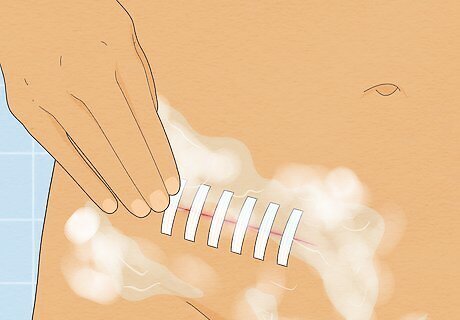
Clean the incision site with mild soap and water. Wash the incision gently, and avoid rubbing the area with a washcloth (which can irritate the incision and delay the healing process). To rinse off the soap, let clean water run over the area until there aren’t any remaining suds. Depending on your dressing, your doctor may advise you to remove it before showering, leaving the incision site uncovered. Try not to let other bath products (like shampoo or conditioner) seep into the incision site. To prevent surgical site infections, your doctor might recommend an antiseptic soap like Hibiclens. Since it’s a strong disinfectant, avoid applying the product on your face, and do not wash with normal soap after using it.
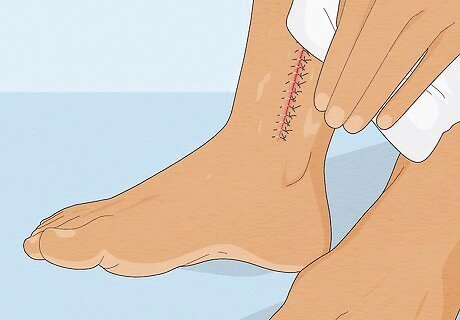
Pat the incision dry, then inspect the area for any signs of infection. If your incision is still covered with a dressing when you get out of the shower, remove it to ensure the area is completely dry. With clean hands, gently dry the incision with a clean towel (even if it didn’t get wet), and check the area for any bleeding, swelling, odor, or white discharge. Avoid rubbing the area, and do not remove any visible stitches, staples, or wound closure strips that are still in place. Even if your incision area is itchy, try not to pick at it to prevent bleeding. Allow any scab to remain until they naturally fall off, which typically takes around 1-2 weeks. If your incision bleeds (or you notice any possible signs of infection), apply direct, constant pressure over the area and contact your doctor for further instructions.
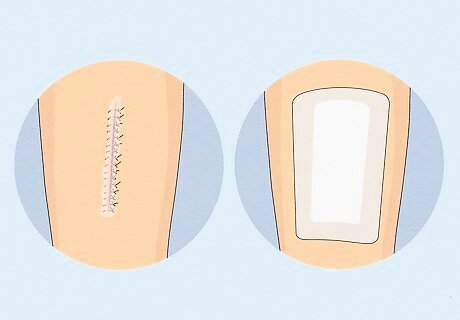
Apply a prescribed cream or ointment directly on the incision. If your doctor prescribes a topical treatment, apply a thin, even layer of product over the incision site. Only apply topical products if your doctor instructs you to. They might advise you to skip this step and changing the wound dressing instead.
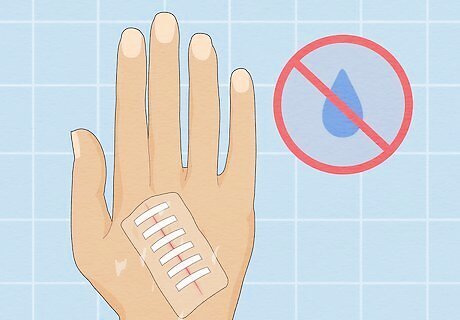
Leave wound closure strips in place. If your incision is covered by Steri-Strips or butterfly band-aids, your doctor may instruct you to keep the area dry for 48 hours post surgery. You can tape a plastic bag or glove over the wound while showering, but gently pat the area dry when they’re in place. After this time period, you can wet the wound closure strips, but avoid submerging them in water. If the edges of the strips become loose, trim them with a pair of scissors. But, do not pull on the edges or attempt to remove the strips until they fall off naturally (usually within 2 weeks).
Keeping the Incision Dry
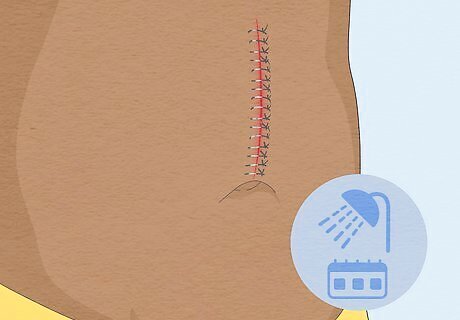
Follow your surgeon’s directions for keeping the incision dry. Depending on your surgery and wound closure, your doctor may instruct you to delay showering for 24-72 hours after surgery. Prematurely wetting the incision site may lead to infection, so be sure to follow your doctor’s instructions and ask them any questions. During this time period, keep clean gauze pads nearby just in case you need to pat the area dry.
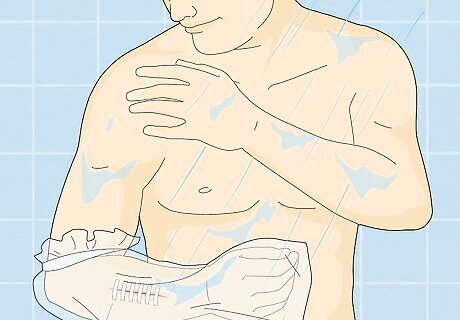
Protect the incision with a waterproof material while showering. Depending on the specific instructions provided by your surgeon, you may be able to shower within 24 hours (if you can cover the incision properly). Wrap the incision site with cling wrap or a plastic bag, then use medical tape to secure the edges in place. For hard to reach areas, ask a family member or friend to help you cover it so water doesn’t seep into the wound. Alternatively, you can purchase a waterproof dressing to place directly over the wound and keep the area dry. If the wound is on your shoulder or upper back, drape a garbage bag like a cape to keep water away from the area. You can also drape the bag like a bib to protect chest incisions.
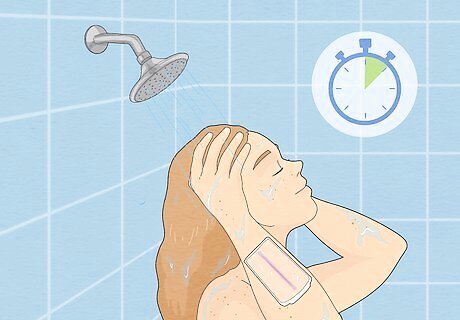
Take quick showers during the first week post surgery. In general, most surgeons recommend starting off with 5-minute showers so the incision can heal properly. Let water gently run over the incision area, instead of letting the water spray directly on it.
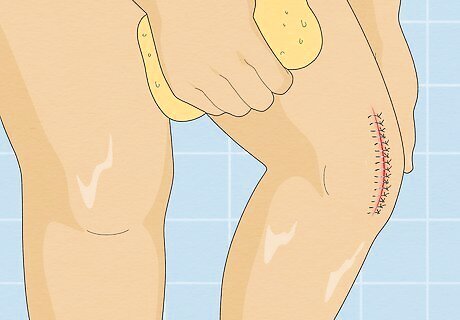
Take a sponge bath to avoid soaking the incision. If you don’t feel comfortable taking a shower, you can ask someone to help give you a sponge bath instead. Ask them to dip a sponge (or washcloth) in mild soapy water and blot each area dry as they go. Depending on your doctor’s instructions, sponge bathe around the incision site until you can wet it. After the sponge bath, pay extra attention to your incision and make sure it’s completely dry.
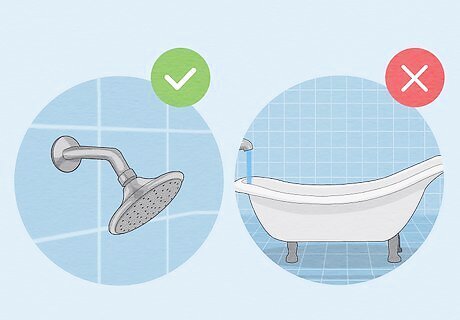
Avoid taking a bath for at least 2 weeks post surgery. Most surgeons recommend showers over baths, especially during the first 2-3 weeks of recovery. Soaking the area may increase your risk for infection, so avoid swimming or submerging the incision in water. If you still have a scab after this time, your incision could still be healing. Consult with your doctor before bathing to ensure it’s safe.
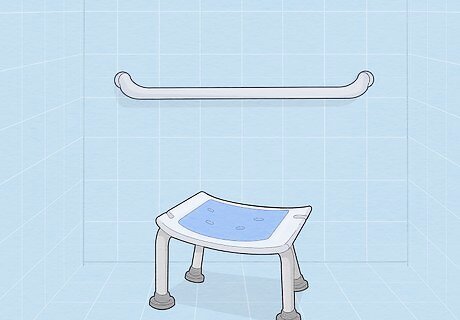
Ask someone to stand nearby when you shower. Surgeries that involve your knees, legs, ankles, feet, and back can make it difficult for you to safely balance in a small shower area. Until you feel strong again, ask a trusted friend or family member to assist you while you shower. You can also use a shower stool or hand rail to provide you with extra stability and prevent falls.
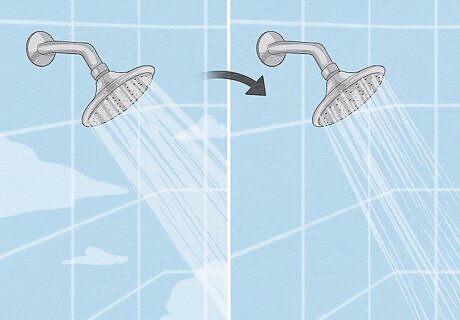
Adjust your water stream to lukewarm and low pressure. Before stepping into the shower, set the water to a comfortable temperature and adjust the flow to a low setting. Position yourself so your incision faces away from the water stream, protecting the area while it heals. Taking a hot shower can weaken the incision and prematurely open up the area, especially if your incision is closed with tissue glue.
Preventing Infection
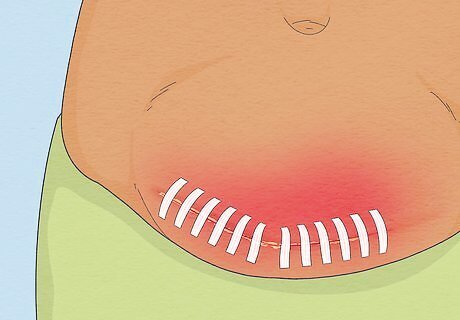
Recognize the symptoms of infection. Infection is the most common complication that develops from having surgery, so contact your doctor immediately if you develop any of the following symptoms: A temperature of 101°F (38.3°C) or higher Nausea and vomiting Severe pain A new redness at the incision site Tenderness A feeling of warmth to the touch Drainage that has an odor or is green or yellow in color New swelling around the area of the incision

Determine if you are at higher risk of infection. Some characteristics and situations make people more likely to develop an infection, or to have their incision re-open, than others: People who are obese or have underlying conditions People with weakened immune systems malnutrition People taking certain medications like corticosteroids Smokers Older people People taking longer or complicated surgeries

Take precautions regarding basic hygiene. To prevent surgical site infections at home, follow your doctor’s care instructions closely. Always wash your hands before and after touching your incision, keep your dressings dry and clean, and make sure to take any prescribed medications. Advise family members and visitors to wash their hands before coming into contact with you. Stop smoking at least 2 weeks prior to the surgery if possible, though four to six weeks is preferable. Smoking slows down the healing process, depriving your tissues of oxygen and potentially causing infection.
When to Contact a Doctor
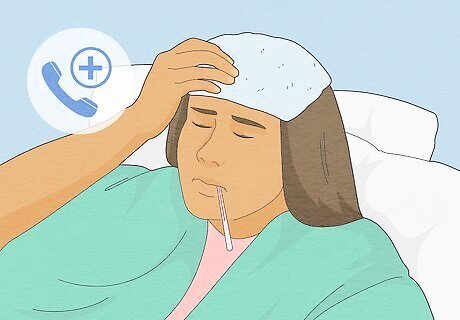
Call your doctor if you develop a fever. Low-grade fevers following major surgery are not uncommon, but temperatures of 101°F (38.3°C) or higher may indicate an infection. Other signs of an infection that warrant contacting your doctor immediately include new areas of redness around the site, pus drainage from the incision, drainage that has an odor or is discolored, tenderness in the area, warmth to the touch, or new swelling in the area of the incision.

Visit your doctor if the incision starts to bleed. Until you can reach your doctor or another medical facility, wash your hands thoroughly, then apply gentle pressure using clean gauze pads or clean towels.

Seek medical attention if you develop any unusual symptoms. If you develop abdominal pain, nausea or vomiting, or jaundice (yellowing of the skin or eyes), see a doctor as soon as possible. Additionally, contact your doctor if you show the following symptoms of a blood clot: paleness, the extremity is cool to the touch, chest pain, shortness of breath, unusual swelling in an arm or leg.




















Comments
0 comment